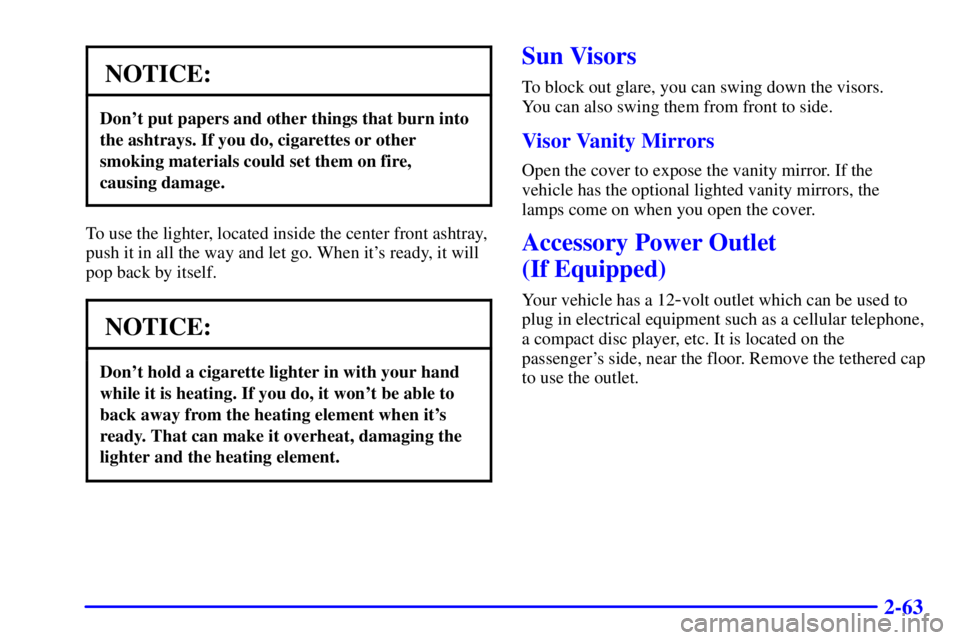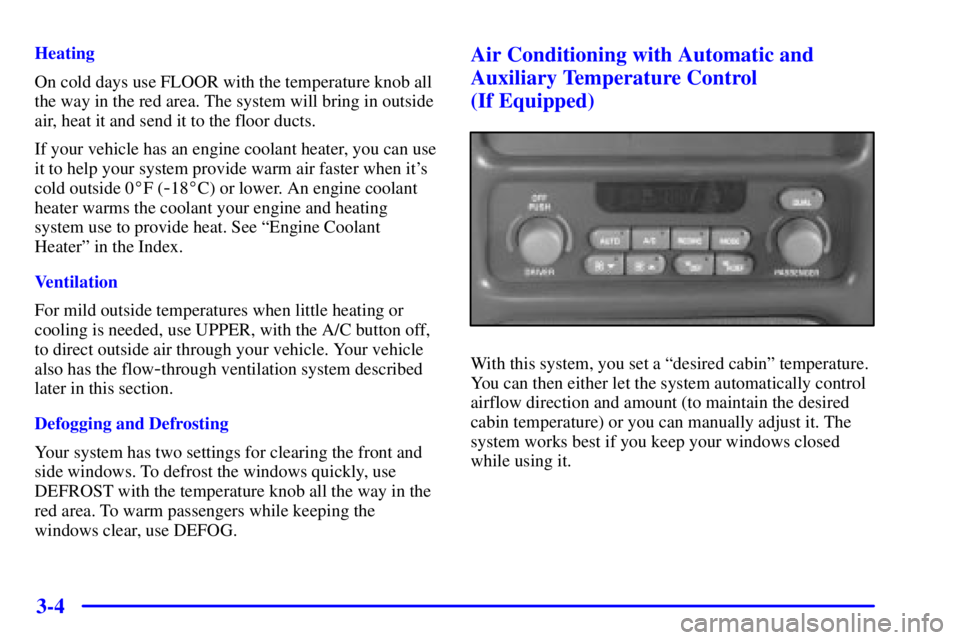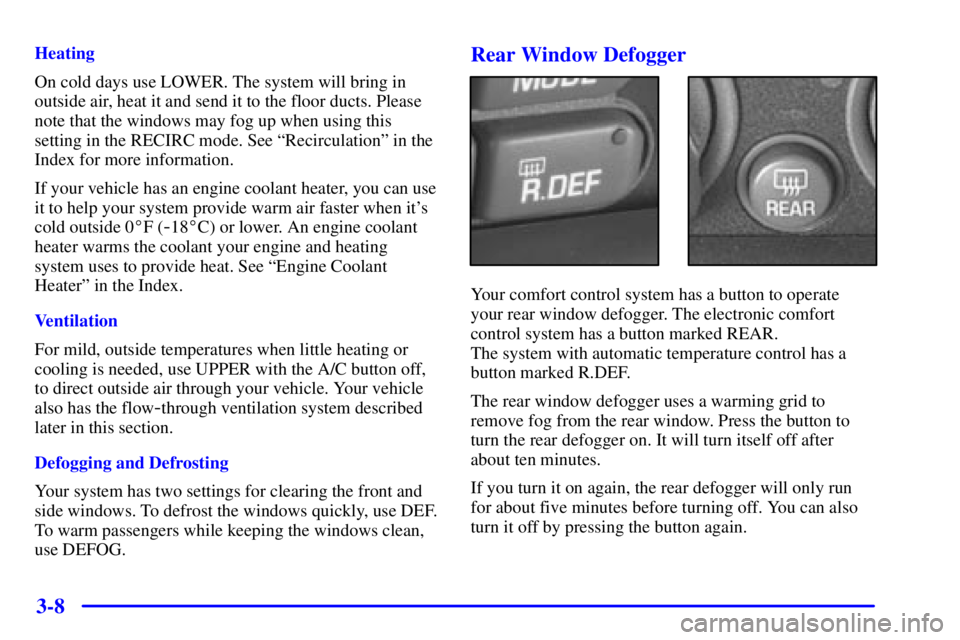Page 5 of 376
Table of Contents (cont'd)
Defensive Driving
Drunken Driving
Conrol of a Vehicle
Braking
SteeringDriving Tips for Various Road Conditions
Recreational Vehicle Towing
Loading Your Vehicle
Towing a Trailer Heating and Air Conditioning
Setting the Radio Clock
Radio/Cassette Player/CD PlayerRadio Theft-Deterrent Feature
Steering Wheel Controls (If Equipped)
Hazard Warning Flashers
Jump Starting
Towing Your VehicleEngine Overheating
Changing a Flat Tire
If You're Stuck
Problems on the Road
Section
3
Section
4
Section
5
Your Driving and the Road Comfort Controls and Audio Systems
iii
Page 91 of 376

2-23
Trunk
CAUTION:
It can be dangerous to drive with the trunk open
because carbon monoxide (CO) gas can come into
your vehicle. You can't see or smell CO. It can
cause unconsciousness and even death.
If you must drive with the trunk open or if
electrical wiring or other cable connections must
pass through the seal between the body and
the trunk:
�Make sure all other windows are shut.
�Turn the fan on your heating or cooling
system to its highest speed with the setting
on VENT. That will force outside air into
your vehicle. See ªComfort Controlsº in
the Index.
�If you have air outlets on or under the
instrument panel, open them all the way.
See ªEngine Exhaustº in the Index.
Trunk Lock
To unlock the trunk from the outside, insert the master
key and turn the key clockwise. You can also press the
trunk symbol on the remote keyless entry transmitter
(if equipped).
Remote Trunk Release (If Equipped)
Press the button located
behind the glove box door
to unlock the trunk from
inside the vehicle.
The shift lever must be in PARK (P) for the remote
trunk release button to work.
Page 131 of 376

2-63
NOTICE:
Don't put papers and other things that burn into
the ashtrays. If you do, cigarettes or other
smoking materials could set them on fire,
causing damage.
To use the lighter, located inside the center front ashtray,
push it in all the way and let go. When it's ready, it will
pop back by itself.
NOTICE:
Don't hold a cigarette lighter in with your hand
while it is heating. If you do, it won't be able to
back away from the heating element when it's
ready. That can make it overheat, damaging the
lighter and the heating element.
Sun Visors
To block out glare, you can swing down the visors.
You can also swing them from front to side.
Visor Vanity Mirrors
Open the cover to expose the vanity mirror. If the
vehicle has the optional lighted vanity mirrors, the
lamps come on when you open the cover.
Accessory Power Outlet
(If Equipped)
Your vehicle has a 12-volt outlet which can be used to
plug in electrical equipment such as a cellular telephone,
a compact disc player, etc. It is located on the
passenger's side, near the floor. Remove the tethered cap
to use the outlet.
Page 144 of 376
2-76 Engine Coolant Temperature Light
This light tells you that the
engine coolant has
overheated or the radiator
cooling fan is not working.
If you have been operating the vehicle under normal
driving conditions, you should pull off the road, stop the
vehicle and turn off the engine as soon as possible.
See ªEngine Overheatingº in the Index.
Engine Coolant Temperature Gage
United States Canada
You have a gage that shows the engine coolant
temperature. If the gage pointer moves into the red area,
the engine is too hot!
That reading means the same thing as the warning light.
It means that the engine coolant has overheated. If you
have been operating the vehicle under normal
conditions, you should pull off the road, stop the
vehicle, and turn off the engine as soon as possible.
See ªEngine Overheatingº in the Index.
Page 163 of 376

3-2
Comfort Controls
Air Conditioning with Electronic Controls
With this system, you can control the heating, cooling
and ventilation in your vehicle. The system works best if
you keep your windows closed while using it.
Fan Knob
The left knob selects the amount of air you want. To turn
the fan off, turn the knob to OFF. The fan must be on to
run the air conditioning compressor.Temperature Knob
The center knob changes the temperature of the air
coming through the system. Turn this knob toward red
(clockwise) for warmer air. Turn it toward blue
(counterclockwise) for cooler air.
Mode Knob
The right knob has several settings to control the
direction of airflow:
MAX: This setting recirculates much of the air
inside your vehicle and sends it through the instrument
panel outlets. The air conditioning compressor will run
automatically in this setting unless the outside
temperature is below 38�F (3.3�C). (Even when the
compressor is running, you can control the temperature.)
UPPER: This setting brings in outside air and
directs it through the instrument panel outlets.
BI-LEVEL: This setting brings in outside air and
directs it two ways. Half of the air is directed through
the instrument panel outlets. Most of the remaining air is
directed through the floor ducts and a small amount to
the defrost and side window vents.
Page 165 of 376

3-4
Heating
On cold days use FLOOR with the temperature knob all
the way in the red area. The system will bring in outside
air, heat it and send it to the floor ducts.
If your vehicle has an engine coolant heater, you can use
it to help your system provide warm air faster when it's
cold outside 0�F (
-18�C) or lower. An engine coolant
heater warms the coolant your engine and heating
system use to provide heat. See ªEngine Coolant
Heaterº in the Index.
Ventilation
For mild outside temperatures when little heating or
cooling is needed, use UPPER, with the A/C button off,
to direct outside air through your vehicle. Your vehicle
also has the flow
-through ventilation system described
later in this section.
Defogging and Defrosting
Your system has two settings for clearing the front and
side windows. To defrost the windows quickly, use
DEFROST with the temperature knob all the way in the
red area. To warm passengers while keeping the
windows clear, use DEFOG.
Air Conditioning with Automatic and
Auxiliary Temperature Control
(If Equipped)
With this system, you set a ªdesired cabinº temperature.
You can then either let the system automatically control
airflow direction and amount (to maintain the desired
cabin temperature) or you can manually adjust it. The
system works best if you keep your windows closed
while using it.
Page 167 of 376

3-6
Hot Weather Example: When you start the vehicle in
hot weather, 80�F (27�C) or after being parked during
the day in full sun, if your Driver Set Temperature is
73�F (23�C) and you are in Full Automatic mode, the
system will automatically move the temperature doors to
full cold. The blower will be at low speed momentarily
and then go to the high speed. The air intake will be
recirculated for maximum cooling performance. As the
interior of the vehicle cools down to your desired
comfort point, the blower will decrease and the
temperature door will move to a warmer position to
maintain your desired comfort. As the cabin cools down
or the sun load decreases the system could switch to air
delivered to A/C vents and the floor (BI
-LEVEL mode).
Manual Control
Fan Buttons
The fan buttons select the amount of air you want when
the system is not in AUTO. The display will show the
fan speed by illuminating a maximum of seven fan bars.Mode Button
The center panel has several settings to control the
direction of airflow when the system is not in AUTO.
The indicator light on the button will glow when the
button is pressed. To access the various modes available,
continue to press the MODE button until the desired
mode appears on the display.
If you prefer to manually control the heating, cooling
and ventilation in your vehicle, push UPPER, BI
-LEV,
LOWER, DEFOG or DEF. AUTO will go off the
display. Set the system to the temperature and fan speed
you want. The system will try to maintain the
temperature you set using the mode you select. The
following suggestions will help the system run more
efficiently in manual mode.
RECIRC: This setting recirculates much of the
air inside your vehicle and sends it through the
instrument panel outlets. The air conditioning
compressor will run automatically in this setting unless
the outside temperature is below 38�F (3.3�C).
Please note that operating the system in the
RECIRCULATION mode may cause fogging of the
windows when the weather is cold and damp. To clear
the fog, select either the DEFOG or DEFROST mode
and increase the fan speed. To avoid re
-fogging of the
windows, use the OUTSIDE AIR mode.
Page 169 of 376

3-8
Heating
On cold days use LOWER. The system will bring in
outside air, heat it and send it to the floor ducts. Please
note that the windows may fog up when using this
setting in the RECIRC mode. See ªRecirculationº in the
Index for more information.
If your vehicle has an engine coolant heater, you can use
it to help your system provide warm air faster when it's
cold outside 0�F (
-18�C) or lower. An engine coolant
heater warms the coolant your engine and heating
system uses to provide heat. See ªEngine Coolant
Heaterº in the Index.
Ventilation
For mild, outside temperatures when little heating or
cooling is needed, use UPPER with the A/C button off,
to direct outside air through your vehicle. Your vehicle
also has the flow
-through ventilation system described
later in this section.
Defogging and Defrosting
Your system has two settings for clearing the front and
side windows. To defrost the windows quickly, use DEF.
To warm passengers while keeping the windows clean,
use DEFOG.
Rear Window Defogger
Your comfort control system has a button to operate
your rear window defogger. The electronic comfort
control system has a button marked REAR.
The system with automatic temperature control has a
button marked R.DEF.
The rear window defogger uses a warming grid to
remove fog from the rear window. Press the button to
turn the rear defogger on. It will turn itself off after
about ten minutes.
If you turn it on again, the rear defogger will only run
for about five minutes before turning off. You can also
turn it off by pressing the button again.